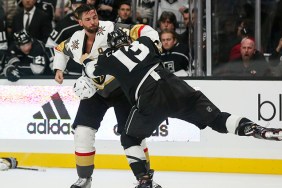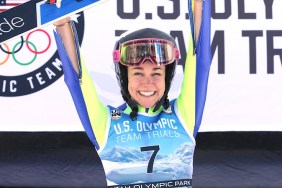(Photo: Hilary Knight with Team USA before the Sochi Olympics)
Growing up in northern Illinois, hockey superstar Hilary Knight was always on the ice.
From a young age, the 26-year-old emulated her favorite National Hockey League players, since professional women’s leagues were scarce. But in 1998, the sport took its first step towards proving it could compete on both the national and international stage with the addition of women’s hockey to the Nagano Winter Olympic Games, giving young girls like Knight a whole new list of names to admire. It was then, while watching United States players Cammi Granato and Angela Ruggiero take home a gold medal, that Knight knew she wanted to follow in their footsteps.
With an NCAA National championship, five gold IIHF World Women’s Championships and two Olympic silver medals under her belt, Knight is regarded as one of the most decorated players in women’s hockey. However, late last year, the former Wisconsin Badger added a new title to her résumé.
Professional Women’s Hockey Player.
For the last three months, Knight – along with 71 of the world’s most talented women – has been crucial in getting the National Women’s Hockey League (NWHL) off of the ground. While the league is not the first of its kind in North America – thanks to two Canadian leagues: the Western Women’s Hockey League (WWHL) and the Canadian Women’s Hockey League (CWHL) – it’s the first to pay women for their participation, with team salary caps of $270,000 and a minimum of $10,000 per player. Made up of four teams – the Boston Pride, the Buffalo Beauts, the Connecticut Whale and the New York Riveters – the NWHL held an expansion draft last summer to decide how the talent would be dispersed.
“I think it’s fascinating and fun at the same time, to be building such an incredible league from the ground up and to be a cornerstone for one of these things,” said Knight.

NEW YORK, NY – SEPTEMBER 16: Members of the New York Riveters of the National Womens Hockey League pose for a group photo. (Photo by Bruce Bennett/Getty Images)
THE MELTING POT
Much like the NHL, the NWHL is a melting pot of talent and while a high amount of players are from the United States and spent time playing college hockey, nearly 30 percent is from other areas of the globe – take Riveters forward Janine Weber, for example. Weber, 24, is an Austrian native who, growing up, was told girls don’t play hockey – in fact, sports aren’t even offered in Austria’s colleges. That didn’t seem to bother Weber, who played just for fun and, after a trip to the Beantown Tournament to compete with a friend, ended up getting noticed by coaches at Providence College. She soon joined the Riveters, becoming the first player in the history of the NWHL to sign a contract.
“I never thought I’d be playing hockey for a living, so I just had fun and that was the one reason why I kept doing it,” Weber admitted. “[The NWHL] is pretty similar [to the NHL], I think. Players are older and they’ve already went through college and have more experience.”
Many of the other international NWHL players followed similar paths to chase their dreams, the most unique of which might be Weber’s teammate, goaltender Nana Fujimoto. Signed in late July, Fujimoto, 26, helped Japan qualify for the 2014 Sochi Olympics and was named best goaltender at the 2015 IIHF Women’s World Championships, an honor that certainly helped her gain notoriety.
“It’s really cool for girls in Japan to see that this is an opportunity and if they want to follow in Fujimoto’s footsteps. Just to know that they have a chance to, it’s pretty awesome,” Weber added.
PREPARING DURING THE WEEK

NEW YORK, NY – SEPTEMBER 16: (l-r) Elena Orlando and Kiira Dosdall of the New York Riveters of the National Womens Hockey League get fitted for equipment. (Photo by Bruce Bennett/Getty Images)
With NWHL games slated only on the weekends, there’s plenty of time for players to get ready during the work week. Monday, the day following a game, is typically an off day for the players and while the rest of the week varies between the four franchises, there are many consistencies in the preparation process. Take the Whale, for instance: practices are slated for Tuesday and Friday night, with an agility workout before even hitting the ice. Practices begin at 10:10 p.m., something unique for a professional franchise, and last about an hour and a half, depending on what the team goes over. But attending practice isn’t always easy, just ask Whale forward – and Knight’s USA teammate – Kelli Stack.
Stack, 28, is one of the NWHL’s biggest names – a proven winner at every level. For Stack, practice is an all night affair, as it’s nearly a two hour drive to the facility from her western Massachusetts home. But, as Stack admits, the players make sure their time together is time well spent.
“For me, by the end of it, I’m tired because I drive two hours to get there and then we do the agility and then we practice and then it’s another two hour drive home. But we try to get the most time out of our time on the ice, because we’re only together practicing twice a week.”
Not all of the league’s players can make practices, however. Due to prior responsibilities or other full-time jobs, many work out on their own, making time either before work, after work, or during their free time. Because of their salaries, most players cannot live solely on their NWHL wage, so continue to focus on their careers, or pick up a second job to make ends meet. It’s not always easy to balance traveling, life and practice, claims Knight, but she wouldn’t seem to have it any other way.
“I don’t think, unless you’re in the league, or in my shoes, you understand the commitment of traveling and training and trying to juggle all of these things together but I absolutely love training and playing with my teammates and traveling and spreading the love of the game of hockey,”

FOXBORO, MA – DECEMBER 31: Emmanuelle Blais #47 of the Les Canadiennes (CWHL) skates against the Boston Pride (NWHL) during the Outdoor Womens Classic at Gillette Stadium on December 31, 2015 in Foxboro, Massachusetts. (Photo by Maddie Meyer/Getty Images)
BUILDING A REPITOIRE
A professional North American sports league can only grow with support, not just from fans but through the partnership of corporate sponsors. Last December, the NWHL landed a league-wide sponsor that helped put it on the map and proved it means business. Dunkin’ Donuts, a Massachusetts based company, expressed interest in the league during the creation phase and, before long, the two sides came to terms – a partnership the NWHL hopes will pave the way for many others.
“It’s huge having Dunkin’ Donuts as a sponsor,” Stack said. “To get someone like them to believe what we’re doing and to support our league, that’s what we needed in our first year – a big name like that to support us and help us grow. Our future is bright with a company like that.”
Growing the brand requires more than just sponsors, though, and in today’s tech-savvy landscape, social media might prove to be the most useful tool in the NWHL’s arsenal. Now, with the power of Facebook and Twitter, these women are gaining fans outside of the Northeastern United States – from the west coast, to South America and throughout all areas of the globe. There are women everywhere who play, who enjoy the sport and who are rooting these women on as they capture their dreams.
“There’s women all over the world that play hockey,” Knight declared. “I’m always shocked when I get a message in Spanish, or whatever language it is. We just tend to think of hockey as a North American game, with all due respect to different European countries, but it’s always remarkable to hear about people from Australian playing, or people from Brazil, or wherever it is and they kind of chime in at key moments when I’m on Twitter or Instagram – and you kind of just take a step and think, ‘wow, hockey is everywhere’ and it’s such a fun sport and culture and community to be a part of.”
Being conduit is important to Knight and every player, to help groom the next generation.
“You’re giving younger girls hope that there are places to play and if they work on certain skills, they can come to the United States and compete with the best,” she added. “I think it’s super important from a fan development perspective but also from a women’s hockey perspective.”

Boston Pride’s forward Madison Packer (R) is tackled by Marissa Gedman of New York Riveters during their game of the first season of the National Womens Hockey League. (Photo credit: Getty Images)
THE POTENTIAL FOR EXPANSION
With success comes growth and while the NWHL might just consist of four teams now, there’s no doubt that if it continues to grow and build an audience, it could move to other cities. This kind of thing certainly takes time, for example, it took the NHL 50 seasons before it expanded from six teams to 12. It remains to be seen what the NWHL’s plans are or what cities might be a good fit for a franchise, but that cannot stop some of the players from dreaming about playing in front of their hometown.
“It would be awesome to play for a team in Cleveland,” Stack, an Ohio native, said. “It’s a huge sports town and I think a [professional] women’s team would do well there. I haven’t been home in over 10 years for more than two weeks at a time, so to be able to play the sport I love there would probably be the best feeling in the world.”
But the current focus is on producing a quality product and impacting the local community. If the NWHL can continue what it’s done these past several months, expansion will be sure to follow.
“Right now, I’m trying like everyone else to help [the NWHL] grow and make it sustainable and get little kids into it,” Weber admitted. “Hopefully, in many years looking back, we’ll still be around and I think that would be cool to know we were a part of it and there from the very beginning.”
Ed Miller is a contributor for CraveOnline Sports. You can follow him on Twitter @PhillyEdMiller or “like” CraveOnline Sports on Facebook.
Photos: Getty








